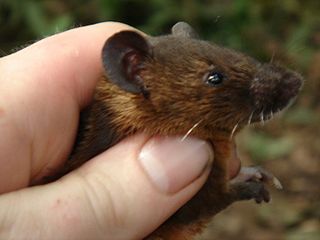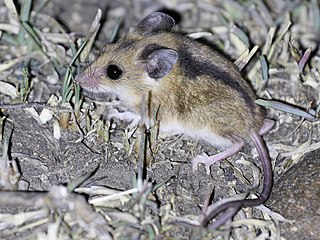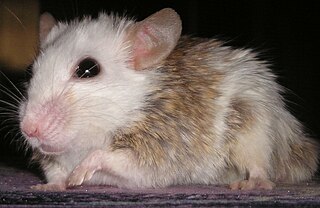
The Nesomyidae are a family of African rodents in the large and complex superfamily Muroidea. It includes several subfamilies, all of which are native to either continental Africa or to Madagascar. Included in this family are Malagasy rodents, climbing mice, African rock mice, swamp mice, pouched rats, and the white-tailed rat.

Dendromurinae is a subfamily of rodents in the family Nesomyidae and superfamily Muroidea. The dendromurines are currently restricted to Africa, as is the case for all extant members of the family Nesomyidae. The authorship of the subfamily has been attributed to both Alston, 1876, and (incorrectly) to G. M. Allen, 1939.

The brush-furred mice, genus Lophuromys are a group of rodents found in sub-Saharan Africa. They are members of the subfamily Deomyinae, a group only identifiable through molecular analysis. Lophuromys is also known as the brush-furred rats, harsh-furred rats or coarse-haired mice.
The link rat is a species of rodent in the family Muridae. It is also known by the common name Congo forest mouse. It is native to central Africa.
The Mount Kahuzi climbing mouse is a rodent found only in the Democratic Republic of the Congo. It is listed as a critically endangered species due to illegal logging; it is also threatened by fire. Only two specimens have ever been found. Both were found within 100m of each other on Mount Kahuzi. Its body length is 50-100mm and its tail length is 65-132mm. Its habitat is tropical forests, and to navigate these forests it may use its semi-prehensile tail to hold on to tree branches. Its markings are brownish on the top and white to yellow on its underside, with strongly dark rings around its eyes. As with other Dendromus, it has three well defined toes.

Dollman's tree mouse is a poorly understood climbing mouse from central Africa. It is unique enough that it has been placed in a genus of its own, Prionomys, since its discovery in 1910.
Chiropodomys is a genus of Old World rats and mice native to Southeast Asia and northeast India. They are tree-dwelling, very small mice, mostly found in tropical rainforest. In total six extant species have been identified, but only one of these, Chiropodomys gliroides, is common and widely distributed, and has been extensively studied.
The montane African climbing mouse or remarkable climbing mouse is a species of rodent in the family Nesomyidae. It is found in Democratic Republic of the Congo, Kenya, Rwanda, Tanzania, and Uganda.
The Kivu climbing mouse is a species of rodent in the family Nesomyidae. It is found in Burundi, Democratic Republic of the Congo, Rwanda, Malawi, Tanzania, Uganda, and Zambia. Its natural habitats are subtropical or tropical moist montane forests, subtropical or tropical high-altitude grassland, swamps, arable land, and plantations.

Lovat's climbing mouse is a species of rodent in the family Nesomyidae. It is found only in Ethiopia. Its natural habitat is subtropical or tropical high-altitude grassland. It is threatened by habitat loss.

The gray climbing mouse is a species of rodent in the family Nesomyidae. It is found in Angola, Benin, Botswana, Democratic Republic of the Congo, Ethiopia, Guinea, Liberia, Malawi, Mozambique, Namibia, Nigeria, Rwanda, South Africa, Eswatini, Tanzania, Uganda, Zambia, and Zimbabwe. Its natural habitats are dry savanna, Mediterranean-type shrubby vegetation, subtropical or tropical dry lowland grassland, and temperate desert.
Brants's climbing mouse is a species of rodent in the family Nesomyidae. It is found in Botswana, Democratic Republic of the Congo, Kenya, Malawi, Mozambique, Namibia, South Africa, Tanzania, and Zambia. Its natural habitats are subtropical or tropical moist montane forests, dry savanna, Mediterranean-type shrubby vegetation, and subtropical or tropical high-altitude grassland.

The chestnut climbing mouse is a species of rodent in the family Nesomyidae. It is found in Angola, Democratic Republic of the Congo, Ethiopia, Kenya, Lesotho, Malawi, Mozambique, Rwanda, South Africa, Eswatini, Tanzania, Uganda, Zambia, and Zimbabwe. Its natural habitats are dry savanna and moist savanna.
The Nyika climbing mouse is a species of rodent in the family Nesomyidae. It is found in Angola, Democratic Republic of the Congo, Malawi, Mozambique, South Africa, Tanzania, Zambia, and Zimbabwe. Its natural habitat is moist savanna.
The Cameroon climbing mouse is a species of rodent in the family Nesomyidae which is endemic to the montane grasslands on three mountains in Cameroon.

Mastomys is a genus of rodent in the family Muridae endemic to Africa. It contains eight species:
The tiny fat mouse is a species of rodent in the family Nesomyidae. It is found in Angola, Botswana, Ethiopia, Kenya, Mozambique, Namibia, South Sudan, Tanzania, Uganda, Zambia, and Zimbabwe. Its natural habitats are subtropical or tropical dry shrubland and subtropical or tropical dry lowland grassland.

The cerrado climbing mouse or long-tailed rhipidomys is an arboreal rodent species in the family Cricetidae from South America. It is found in primary or secondary forests of the cerrado and caatinga in central and eastern Brazil, and has also been seen in the Atlantic Forest. Its karyotype is 2n = 44, FN = 48-52. They are nocturnal animals and can be found in both tree canopies and on the ground.








